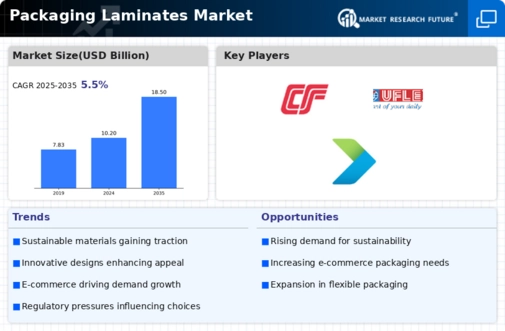Market Share
Packaging Laminates Market Share Analysis
Within the Packaging Laminates Market, companies employ a spectrum of market share positioning strategies to establish a competitive stronghold and cater to the diverse needs of the packaging industry. A central strategy revolves around material innovation. Companies invest in research and development to create laminates that offer enhanced barrier properties, ensuring the protection and preservation of packaged goods. By incorporating features such as high puncture resistance, moisture barrier, and extended shelf life, brands position themselves as providers of reliable and advanced packaging solutions, gaining favor among manufacturers in various sectors.
Pricing strategies play a pivotal role in determining market share within the Packaging Laminates Market. Some companies adopt a cost leadership approach, positioning their laminates as cost-effective and versatile for a broad range of packaging applications. This strategy is effective in attracting cost-conscious clients seeking efficient packaging solutions. Conversely, premium pricing strategies focus on positioning laminates as high-quality, specialized materials. Brands that emphasize superior printability, advanced barrier technologies, and customizable features target clients in industries where packaging plays a crucial role in brand identity and product differentiation.
Effective marketing is fundamental to market share positioning within the Packaging Laminates Market. Companies invest in comprehensive marketing campaigns to showcase the unique features and benefits of their laminates. Emphasizing sustainability, ease of use, and compatibility with various printing techniques, brands create engaging content that resonates with packaging professionals and decision-makers. Digital platforms, industry events, and collaborations with packaging trade publications provide avenues for brands to increase visibility and credibility within the market.
Optimizing distribution channels is integral to market share positioning. Strategic partnerships with packaging converters, food manufacturers, and consumer goods companies ensure that laminates reach a wide range of industries. Collaborations with distributors and packaging suppliers contribute to the accessibility and availability of laminates, enabling brands to meet the diverse demands of clients in different sectors.
Strategic collaborations and partnerships within the Packaging Laminates Market contribute significantly to market share positioning. Aligning with packaging machinery manufacturers, sustainability organizations, and industry associations allows companies to stay abreast of trends and innovations. Collaborations can lead to joint research and development efforts, resulting in the creation of laminates that meet evolving industry standards and address emerging packaging challenges.
Sustainability has become a focal point in market share positioning within the Packaging Laminates Market. With increasing environmental awareness, brands that prioritize recyclability, use of eco-friendly materials, and reduced carbon footprint appeal to environmentally conscious clients. Highlighting these sustainability initiatives through certifications, labeling, and marketing campaigns not only attracts a specific segment of the market but also positions the brand as socially responsible and aligned with global sustainability goals.
Consumer education is crucial in market share positioning within the Packaging Laminates Market. Brands invest in informative content that educates clients on the benefits of specific laminates for their packaging needs. Providing insights into barrier properties, printability, and end-of-life considerations empowers clients to make informed decisions, fostering long-term partnerships and brand loyalty.







Leave a Comment